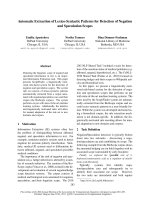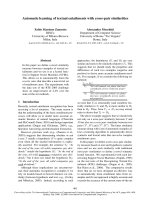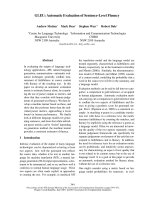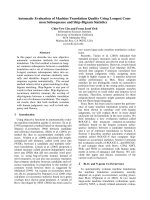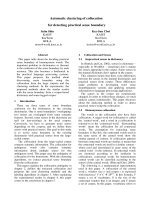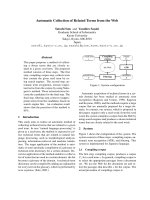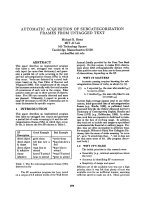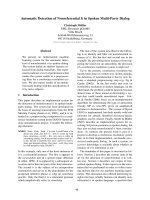Báo cáo khoa học: "Automatic Construction of Frame Representations for Spont aneous Speech in Unrestricted Domains" docx
Bạn đang xem bản rút gọn của tài liệu. Xem và tải ngay bản đầy đủ của tài liệu tại đây (392.62 KB, 5 trang )
Automatic Construction of Frame Representations
for Spontaneous Speech in Unrestricted Domains
Klaus Zechner
Language Technologies Institute
Carnegie Mellon University
5000 Forbes Avenue
Pittsburgh, PA 15213, USA
zechner@cs, cmu.
edu
Abstract
This paper presents a system which automatically
generates shallow semantic frame structures for con-
versational speech in unrestricted domains.
We argue that such shallow semantic representations
can indeed be generated with a minimum amount of
linguistic knowledge engineering and without having
to explicitly construct a semantic knowledge base.
The system is designed to be robust to deal with the
problems of speech dysfluencies, ungrammaticalities,
and imperfect speech recognition.
Initial results on speech transcripts are promising
in that correct mappings could be identified in 21%
of the clauses of a test set (resp. 44% of this test
set where ungrammatical or verb-less clauses were
removed).
1 Introduction
In syntactic and semantic analysis of spontaneous
speech, little research has been done with regard
to dealing with language in unrestricted domains.
There are several reasons why so far an in-depth
analysis of this type of language data has been con-
sidered prohibitively hard:
• inherent properties of spontaneous speech, such
as dysfiuencies and ungrammaticalities (Lavie,
1996)
• word accuracy being far from perfect (e.g., on a
typical corpus such as SWITCHBOARD (SWBD)
(Godfrey et al., 1992), current state-of-the-art
recognizers have word error rates in the range
of 30-40% (Finke et al., 1997))
• if the domain is unrestricted, manual construc-
tion of a semantic knowledge base with reason-
able coverage is very labor intensive
In this paper we propose to combine methods of
partial parsing ("chunking") with the mapping of
the verb arguments onto subcategorization frames
that can be extracted automatically, in this case,
from WordNet (Miller et al., 1993). As prelimi-
nary results indicate, this yields a way of generating
shallow semantic representations efficiently and with
minimal manual effort.
Eventually, these semantic structures can serve as
(additional) input to a variety of different tasks in
NLP, such as text or dialogue summarization, in-
formation gisting, information retrieval, or shallow
machine translation.
2 Shallow Semantic Structures
The two main representations we are building on are
the following:
• chunks: these correspond mostly to basic (i.e.,
non-attached) phrasal constituents
• frames: these are built from the parsed chunks
according to subcategorization constraints ex-
tracted from the WordNet lexicon
The chunks are defined in a similar way as in (Ab-
ney, 1996), namely as "non-recursive phrasal units";
they roughly correspond to the standard linguistic
notion of constituents, except that there are no at-
tachments made (e.g., a PP to a NP) and that a ver-
bal chunk does not include any of its arguments but
just consists of the verbal complex (auxiliary/main
verb), including possibly inserted adverbs and/or
negation particles.
All frames are being generated on the basis of
"short clauses" which we define as minimal clausal
units that contain at least one subject and an in-
flected verbal form) 2
To produce the list of all possible subcategoriza-
tion frames, we first extracted all verbal tokens from
the tagged SWITCHBOARD corpus and then retrieved
the frames from WordNet. Table 1 provides a sum-
mary of this pre-calculation.
1This means in effect that relative clauses will get mapped
separately. They will, however, have to be "linked" to the
phrase they modify.
2We are also considering to take even shorter units as basis
for the mapping that would, e.g., include non-inflected clausal
complements. The most convenient solution has yet to be
determined.
1448
Verbal tokens
Different lemmata
Senses in all lemmata
Avg. senses per lemma
Total number of frames
Avg. frames per sense
4428
2464
8523
3.46
15467
1.81
Table 1: WordNet: verbal lemmata, senses,
and frames
3 Resources and System
Components
We use the following resources to build our system:
• the SWITCHBOARD
(SWBD)
corpus (Godfrey
et
al., 1992) for speech data, transcripts, and
annotations at various levels (e.g., for segment
boundaries or parts of speech)
• the JANUS speech recognizer (Waibel et al.,
1996) to provide us with input hypotheses
• a part of speech (POS) tagger, derived from
(Brill, 1994), adapted to and retrained for the
SWITCHBOARD corpus
• a preprocessing pipe which cleans up speech
dysfluencies (e.g., repetitions, hesitations) and
contains a segmentation module to split "the
speech recognizer turns into short clauses
• a chart parser (Ward, 1991) with a POS based
grammar to generate the
chunks 3
(phrasal con-
stituents)
• WordNet 1.5 (Miller et al., 1993) for the extrac-
tion of subcategorization (subcat) frames for all
senses of a verb (including semantic features,
such as
"animacy')
• a mapper which tries to find the "best match"
between the chunks found within a short clause
and the subcat frames for the main verb in that
clause
The major blocks of the system architecture are
depicted in Figure I.
We want to stress here that except for the devel-
opment of the small POS grammar and the frame-
mapper, the other components and resources were
already present or quite simple to implement. There
has also been significant work on (semi-)automatic
induction of subcategorization frames (Manning,
1993; Briscoe and Carroll, 1997), such that even
3More
details about the
chunk parser can be found in
(Zechner, 1997).
input urerance
speech recognizer
hypothesis
L
I POS tagger
,
prepro e. ,ngp p II
II; chun par er II
chunk sequence
li II
frame representation
Figure 1: Global system architecture
without the important knowledge source from Word-
Net, a similar system could be built for other lan-
guages as well. Also, the Euro-WordNet project
(Vossen et al., 1997) is currently underway in build-
ing WordNet resources for other European lan-
guages.
4 Preliminary Experiments
We performed some initial experiments using the
SWBD transcripts as input to the system. These
were POS tagged, preprocessed, segmented into
short clauses, parsed in chunks using a POS
based grammar, and finally, for each short clause,
the frame-mapper matched all potential arguments
of the verb against all possible subcategorization
frames listed in the lemmata file we had precom-
puted from WordNet (see section 2).
In total we had over 600000 short clauses, con-
taining approximately 1.7 million chunks. Only 18
different chunk patterns accounted for about half
of these short clauses. Table 2 shows these chunk
1449
main verb frequency chunk sequence
present?
no
no
no
yes
yes
no
no
yes
yes
83353
36731
33182
29749
19176
13834
13623
12220
11038
(noises/hesit.)
aft
conj
np vb
np vb np
np
conj np
conj np vb
conj np vb np
yes
yes
yes
no
yes
no
yes
yes
yes
7649
7092
5552
5044
4926
4079
3999
3998
3996
np vb adjp
np vb pp
np vbneg
advp
np vb np pp
PP
conj np vb pp
conj np vb adjp
np vb advp
Table 2: Most frequent chunk sequences in
short clauses
patterns and their frequencies. 4 Most of these con-
tain main verbs and hence can be sensibly used
in a mapping procedure but some of them (e.g.,
aff, con j, advp) do not. These are typically back-
channellings, adverbial comments, and colloquial
forms (e.g., "yeah", "and ", "oh really"). They can
be easily dealt with a preprocessing module that as-
signs them to one of these categories and does not
send them to the mapper.
Another interesting observation we make here is
that within these most common chunk patterns,
there is only
one
pattern (np vb np pp) which could
lead to a potential PP-attachment ambiguity. We
conjecture that this is most probably due to the na-
ture of conversational speech which, unlike for writ-
ten (and more formal) language, does not make too
frequent use of complex noun phrases that have one
or multiple prepositional phrases attached to them.
We selected 98 short clauses randomly from the
output to perform a first error analysis.
The results are summarized in Table 3. In over
21% of the clauses, the mapper finds at least one
mapping that is correct. Another 23.5% of the
clauses do not contain any chunks that are worth
to be mapped in the first place (noises, hesitations),
4 Chunk abbreviations: conj=conjunction, aft=affirmative,
np=noun phrase, vb=verbai chunk, vbneg=negated ver-
bal chunk, adjp=adjectival phrase, advp=adverbial phrase,
pp=prepositional phrase.
so these could be filtered out and dealt with entirely
before the mapping process takes place, as we men-
tioned earlier. 28.6% of the clauses are in some sense
incomplete, mostly they are lacking a main verb
which is the crucial element to get the mapping pro-
cedure started. We regard these as "hard" residues,
including well-known linguistic problems such as el-
lipsis, in addition to some spoken language ungram-
maticalities. The last two categories (26.6% com-
bined) in the table are due to the incompleteness and
inaccuracies of the system components themselves.
To illustrate the process of mapping, we shall
present an example here, starting from the
POS-tagged utterance up to the semantic frame
representation:5 s
short clause, annotated with POS:
i/PRP wi11/AUX talk/VB
to/PREP you/PRPAagain/RB
LEMMA/token (of main
verb):
talk/talk
parsed
chunks:
-np-vb-pp-advp
parsed sequence to map:
-NP-VBZ-PP
WordNet frames:
:I-INAN-VBZ:I-ANIM-VBZ:I-INAN-IS-VBG-PP
:I-ANIM-VBZ-PP:I-ANIM-VBZ-TO-ANIM
:2-ANIM-VBZ:2-ANIM-VBZ-PP
:3-ANIM-VBZ:3-ANIM-VBZ-INAN
:4-ANIM-VBZ
:5-ANIM-VBZ
:6-ANIM-VBZ:6-INAN-VBZ-TO-ANIM
:6-ANIM-VBZ-ON-INAN
Potential mappings (found by mapper):
map. I: I-NP-VBZ (I-INAN-VBZ)
map. 2:
1-NP-VBZ (I-ANIM-VBZ)
map. 3:
I-NP-VBZ-PP (1-ANIM-VBZ-PP)
map. 4: I-NP-VBZ-PP (1-ANIM-VBZ-TO-ANIM)
( )
Frame representation (for mapping 4):
[agent/an] (i/PRP)
5PO$ abbreviations: PRP=personal pro-
noun, AUX=auxiliary verb, VB=main verb (non-inflected),
PREP=prepositlon. PRPA-personal pronoun in accusative,
RB=adverb.
°Frame abbreviations:
INAN=inanimate NP, ANIM=animate NP, VBZ inflected
main verb, IS=is, VBG=gerund, PP=prepositional phrase,
TO=to (prep.), ONmon (prep.).
1450
classification
correct
non-mappable
ungrammatical
preprocessing
mapper
occ.
(%)
21
(21.4%)
23 (23.5%)
28 (28.6%)
13 (13.3%)
13
(13.3%)
Comment
at least one reasonable mapping is found
clause consists of noises/hesitations only
e.g., incomplete phrase, no verb
problem is caused by errors in POS tagger/segmenter/parser
problem due to incompleteness of mapper
Table 3: Summary of classification results for mapper output
[pred] ([vb_fin] ([aux] (wilI/AUX)
[head] (talk/VB))
[pp_obj] ( [prep] (to/PREP)
[theme/an] (you/PRPA)))
[modif] (again/RB)
Since chunks like advp or conj are not part of the
WordNet frames, we remove these from the parsed
chunk sequence, before a mapping attempt is being
made. 7
In our example, WordNet yields 14 frames for 6
senses of the main verb talk. The mapper already
finds a "perfect match "s for the first, i.e., the most
frequent sense 9 of the verb (mapping 4 can be es-
timated to be more accurate than mapping 3 since
also the preposition matches to the input string).
This will be also the default sense to choose, unless
there is a word sense disambiguating module avail-
able that strongly favors a less frequent sense.
Since WordNet 1.5 does not provide detailed
semantic frame information but only general
subcategorization with extensions such as "ani-
mate/inanimate", we plan to extend this infor-
mation by processing machine-readable dictionaries
which provide a richer set of semantic role informa-
tion of verbal heads, l°
It is interesting to see that even at this early stage
of our project the results of this shallow analysis are
quite encouraging. If we remove those clauses from
the test set which either should not or cannot be
mapped in the first place (because they are either
not containing any structure ("non-mappable") or
are ungrammatical), the remainder of 47 clauses al-
ready has a success-rate of 44.7%. Improvements of
the system components
before
the mapping stage as
well as to the mapper itself will further increase the
mapping performance.
7These chunks
can be easily added to the
mapper's output
again, as shown in the example.
Spartial matches, such as mappings I and 2 in this exam-
ple, are allowed but disfavored to perfect matches.
9In WordNet 1.5, the first
sense is also
supposed to be the
most frequent
one.
l°The "agent" and "theme" assignments are currently just
defaults for
these types of subcat
frames.
5 Future Work
It is obvious from our evaluation, that most core
components, specifically the mapper need to be im-
proved and refined. As for the mapper, there are
issues of constituent coordination, split verbs, infini-
tival complements, that need to be addressed and
properly handled. Also, the "linkage" between main
and relative clauses has to be performed such that
this information is maintained and not lost due to
the segmentation into short clauses.
Experiments with speech recognizer output in-
stead of transcripts will show in how far we still get
reasonable frame representations when we are faced
with erroneous input in the first place. Specifically,
since the mapper relies on the identification of the
"head verb", it will be crucial that at least those
words are correctly recognized and tagged most of
the time.
To further enhance our representation, we could
use speech act tags, generated by an automatic
speech act classifier (Finke et al., 1998) and attach
these to the short clauses. 11
6 Summary
We have presented a system which is able to build
shallow semantic representations for spontaneous
speech in unrestricted domains, without the neces-
sity of extensive knowledge engineering.
Initial experiments demonstrate that this ap-
proach is feasible in principle. However, more work
to improve the major components is needed to reach
a more reliable and valid output.
The potentials of this approach for NLP applica-
tions that use speech as their input are obvious: se-
mantic representations can enhance almost all tasks
that so far have either been restricted to narrow do-
mains or were mainly using word-level representa-
tions, such as text summarization, information re-
trieval, or shallow machine translation.
11 Sometimes, the speech acts will span more than one short
clause but as long as the turn-boundaries are fixed for both
our system and the
speech act classifier, the re-combination
of
short clauses
can be done straightforwardly.
1451
7" Acknowledgements
The author wants to thank Marsal Gavaldh, Mirella
Lapata, and the three anonymous reviewers for valu-
able comments on this paper.
This work was funded in part by grants of the
Verbmobil project of the Federal Republic of Ger-
many, ATR - Interpreting Telecommunications Re-
search Laboratories of Japan, and the US Depart-
meat of Defense.
References
Steven Abney. 1996. Partial parsing via finite-state
cascades. In
Workshop on Robust Parsing, 8th
European Summer School in Logic, Language and
Information, Prague, Czech Republic,
pages 8-15.
Eric Brill. 1994. Some advances in transformation-
based part of speech tagging. In
Proceeedings of
AAAI-94.
Ted Briscoe and John Carroll. 1997. Automatic
extraction of subcategorization from corpora. In
Proceedings of the 5th ANLP Conference, Wash-
ington DC,
pages 24-29.
Michael Finke, Jiirgen Fritsch, Petra Geutner, Klans
Ries and Torsten Zeppenfeld. 1997. The Janus-
RTk
SWITCHBOARD/CALLHOME
1997 Evaluation
System. In
Proceedings of LVCSR HubS-e Work-
shop, May 13-15, Baltimore, Maryland.
Michael Finke, Maria Lapata, Alon Lavie, Lori
Levin, Laura Mayfield Tomokiyo, Thomas Polzin,
Klaus Ries, Alex Waibel and Klaus Zechner. 1998.
CLARITY: Inferring Discourse Structure from
Speech.
In
Proceedings of the AAAI 98
Spring
Symposium: Applying Machine Learning to Dis-
course Processing, Stanford, CA,
pages 25-32
J. J. Godfrey, E. C. Holliman, and J. McDaniel.
1992. SWITCHBOARD: telephone speech corpus
for research and development. In
Proceedings of
the ICASSP-9e,
volume 1, pages 517-520.
Alon Lavie. 1996.
GLR*: A Robust Grammar.
Focused Parser for Spontaneously Spoken Lan-
guage.
Ph.D. thesis, Carnegie Mellon University,
Pittsburgh, PA.
Christopher D. Manning. 1993. Automatic acquisi-
tion of a large subcategorization dictionary from
corpora. In
Proceeedings of the 31th Annual Meet-
ing of the ACL,
pages 235-242.
George A. Miller, Richard Beckwith, Christiane
Fellbaum, Derek Gross, and Katherine Miller.
1993. Five papers on WordNet. Technical report,
Princeton University, CSL, revised version, Au-
gust.
Pick Vossen, Pedro Diez-Orzas, and Wim Peters.
1997.
The Multilingual Design of EuroWordNet.
In
Proceedings of the ACL/EACL-97 workshop
Automatic Information Extraction and Building
of Lezical Semantic Resources for NLP Applica-
tions, Madrid, July I2th, 1997
Alex Waibel, Michael Pinke, Donna Gates, Marsal
Gavaldh, Thomas Kemp, Alon Lavie, Lori Levin,
Martin Maier, Laura Mayfield, Arthur McNair,
Ivica P~gina, Kaori Shima, Trio Sloboda, Monika
Woszczyna, Torsten Zeppenfeld, and Puming
Zhan. 1996. JANUS-II - advances in speech recog-
nition. In
Proceedings of the ICASSP-96.
Wayne Ward. 1991. Understanding spontaneous
speech: The PHOENIX system. In
Proceedings
of ICASSP-91,
pages 365-367.
Klaus Zechner. 1997. Building chunk level rep-
resentations for spontaneous speech in unre-
stricted domains: The CHUNKY system and
its application to reranking Nbest lists of a
speech recognizer. M.S. Project lq~port, CMU,
Department of Philosophy. Available from
http ://www. con~rib, andrew, cmu. edu/'zechner/
publ icat ions. h~ml
1452
